the history of yeovil's pubs
PUBS HOME PAGE |
PUBS INTRODUCTION |
PUBS BY NAME |
BEERHOUSES |
greyhound (1)
Borough
The first Greyhound Inn (marked as 'H' on the 1886 map below) was an inn flourishing in the late 14th century although very little detail is known about it. The Greyhound Inn stood in the Borough and should not be confused with the later Greyhound Inn in South Street.
In his will of 24 August 1580, Gyles Hayne wrote "... Also I geve and bequeathe unto him by my Mothers permission, w[hi]ch I request her to performe and whiche heretofore she hathe consented unto, the Lease and Terme of Yeres yett to come of and in the Tenemente in highestreete nexte the Greyhounde w[hi]ch my mother and he doe nowe dwell in of the Burges lande ...".
The Western Flying Post in April 1790 reported on two suspected arson cases in outhouses behind the Greyhound Inn in the Borough. There was, however, some confusion at the time concerning which public house was burnt as the following was recorded at the court "Alexander Pearce, born at Sherborne, in the County of Dorset, aged 19, was executed at Ilchester, 20 August 1790, for setting fire to the Sun Public House at Yeovil in this County. Denied the fact to his last moment, though unquestionably guilty." (Thomas G Rees, Ordinary to Ilchester Gaol, 1789-1821).
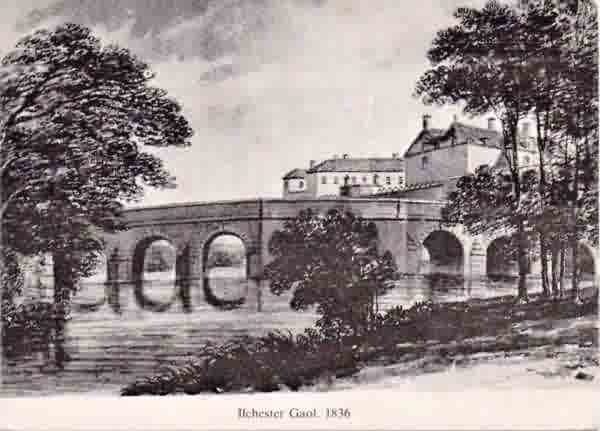
From my
collection
A contemporary sketch of Ilchester Gaol.
However the consensus in the newspapers was that the pub in question was, in fact, the Greyhound Inn and the following account from the 10 May 1790 edition of the Reading Mercury is typical "Saturday fe'nnight a man, servant to Thomas Garland, who keeps the Greyhound inn, in Yeovil, was committed to Ivelchester gaol, on suspicion of his having set fire to his house, whereby the stables, cellar, and a smith's shop adjoining, were entirely destroyed, and the whole town endangered. There have been three fires in the same place in the course of five days, attended with such circumstances as leave little room to doubt its being a premeditated act of some person acquainted with the premises."
The Bath Chronicle & Weekly Gazette, on 2 September 1790, reported "Wednesday (was) executed at Ilchester, Alex. Pearce, aged 19, for setting fire to his master's house and stables at Yeovil.... Alexander Pearce was born at Sherborne, and apprenticed to a taylor, but losing a finger by accident, was obliged to decline that business, and turned labourer. Many strong circumstances appeared on his trial, which plainly proved his guilt, though he declared his innocence to the last of ever having any knowledge of the fact for which he suffered. He appeared very insensible of his approaching fate, and declared that he had never robbed or intentionally injured any one."
In 1848 the
Greyhound was
put up for sale
and the sale
details, as
published in the
1 April 1848
edition of the
Sherborne
Mercury (shown
below), gives a
good description
of the
facilities of
the
establishment -
".... most
eligibly
situated in the
centre of the
Market Place,
with back
entrance from
South Street, to
which is
attached a
commodious
Malt-house,
Brew-house, good
Stabling, and
other convenient
Offices, Yard,
&C., together
with five
substantial
cottages
adjoining, well
tenanted - two
good Bars and
Sitting room on
the ground
floor, good
Kitchen and
roomy Cellarage
underground -
spacious
Market-room and
Sitting-rooms on
the first floor,
and an
appropriate
number of
Bedrooms, &c."
![]()
Few of the licensees are known but Benjamin Rowsell was born about 1767 in Gillingham, Dorset. He was listed as licensee of the Greyhound in Pigot's Directories of both 1822 and 1824. I finally came across him in the 1851 census where he was living in Hendford Terrace as an 84-year old, describing himself as a retired publican.
Some detail is known, however, of John Chandler who was licensee at least between 1827 and 1830. Chandler, of Chirton near Devizes in Wiltshire, was married in Chirton in 1800 and all his children were born there. His youngest child was born in 1818 and at this time Chandler was described as a miller. He moved to Yeovil with his family before September 1827 when his wife, Grace, died. In 1827 he is recorded for the first time as the licensee of the Greyhound. He remarried Hannah Male, a widow, at St John's church, Yeovil, in 1829. He was still the Greyhound's licensee in 1830 but by 1841 he and his family had moved to Keinton Mandeville. When his daughter, Matilda, married in 1845 he was described as an innkeeper but by the time of the 1851 census he was a retired innkeeper living in Barton St David.
Mrs Court was listed as licensee in the Somerset Gazette Directory of 1840. Mary A'Court was born in Somerset around 1800 and in the 1841 census was listed as a housekeeper living with her son, Frederick, and a couple of lodgers. Frederick gave his occupation as innkeeper. Frederick and Mary soon left as Elizabeth Fenton was listed as licensee by 1842. I next found Frederick in the 1851 census living at Long Sutton where he lived with his wife Harriet and three young children. By this time he was working as a coachbuilder as, indeed, he was twenty years later I found him as a 50-year old widower living in Baltonsborough.
Elizabeth Fenton was possibly the last licensee. The Greyhound closed between 1842 (when Elizabeth Fenton was listed) and 1852 when the South Street Greyhound is listed in Slater's Directory. Other than this I could find no other trace of Elizabeth.
map
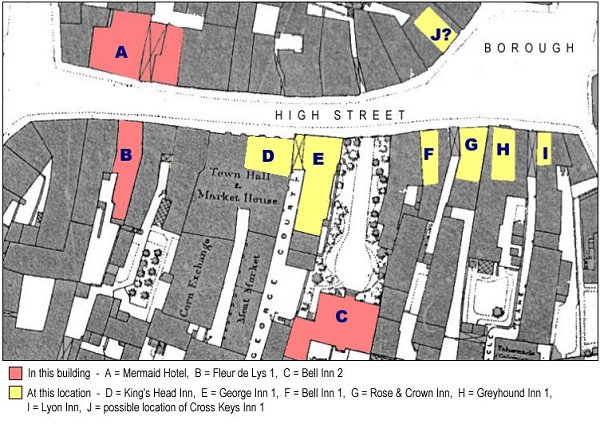
gallery
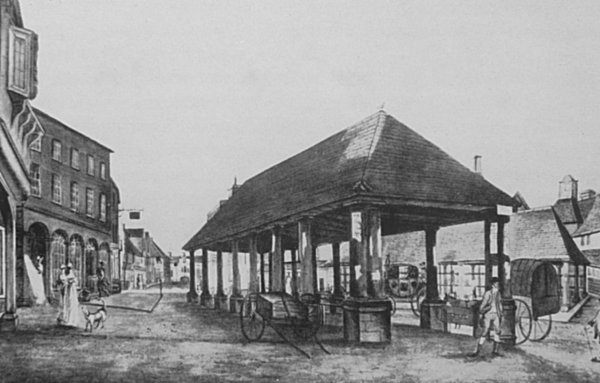
A painting made in 1810 of the Borough looking towards High Street which runs to the Angel Inn in the distance at left. The building at centre was the Market House, built in 1740, and behind it to the right was the butcher's Shambles, built in 1803. At left, the building with the arched ground floor is the only building surviving today in the Borough and originally the ironmongery shop of William Edwards, then Josiah Hannam followed by James Bazeley Petter and then Hill & Sawtell. Today it is Superdrug and is seen in the final photograph of this page. Next to it, but obscured in this drawing, is the Greyhound and its sign is clearly seen projecting into the Borough.
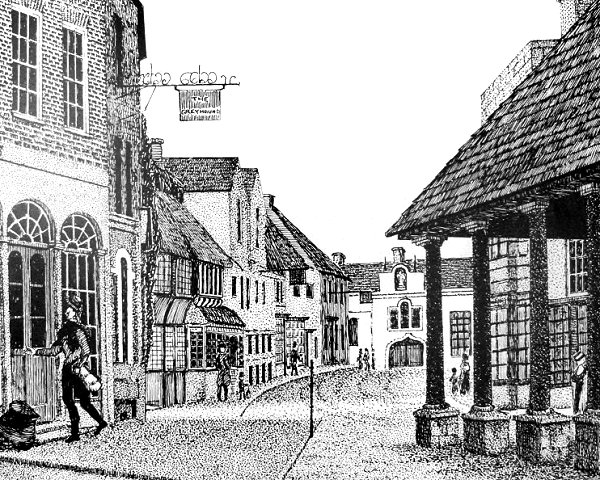
This drawing, by Leslie Brooke based on the above painting, makes it clear that the Greyhound was on the south side of High Street in the Borough.
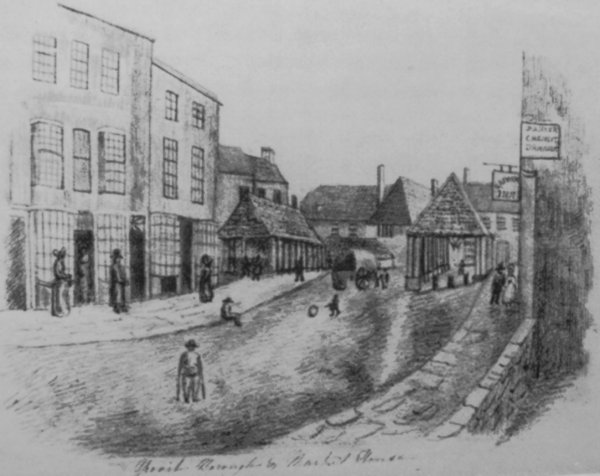
A pencil sketch of the Borough with the Market House and the Shambles, again from about 1810, but sketched from High Street looking towards Middle Street. The artist was standing roughly where King George Street meets High Street today and, just beyond the building at extreme right, the sign of the Greyhound Inn is just seen.
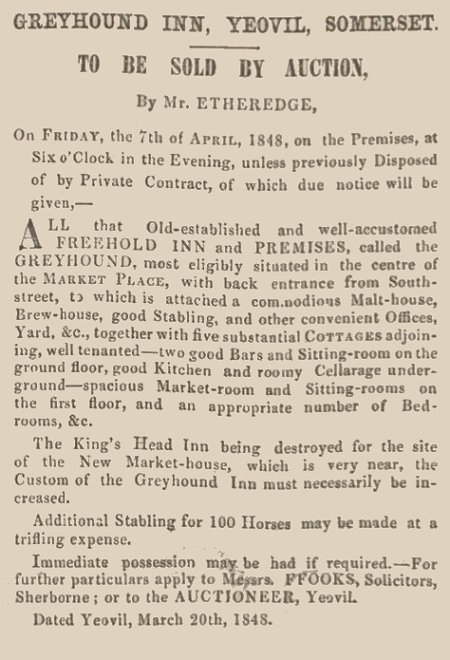
This notice of sale was published in the Sherborne Mercury of 1 April 1848 and gives a good description of the facilities of the establishment.
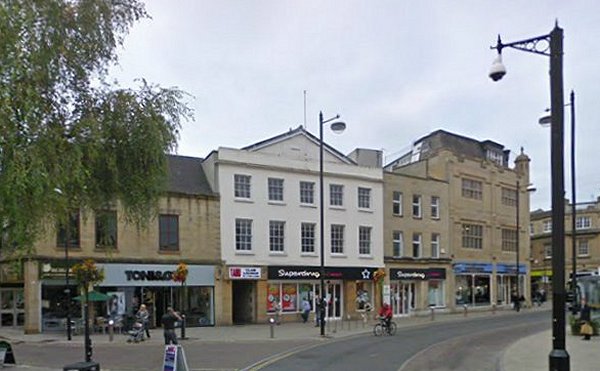
This photograph of the Borough, taken in 2009, shows the site of the Greyhound Inn today as the stone building currently occupied by Superdrug between Superdrug's white building at the centre of the photograph and the building occupied by Cafe Nero to the left of the lamp-post.
owners / tenants / licensees
1790 – Thomas
Garland (see
news articles
above)
1822 – Benjamin
Rowsell (Pigot’s
1822 Directory)
listed as
Greyhound
1824 – Benjamin
Rowsell (Pigot's
1824 Directory -
Inns & Hotels)
listed as
Greyhound,
Borough
1827 – John
Chandler (1827
Jurymen List)
listed as
Greyhound,
Borough
1828 – John
Moody, owner,
John Chandler,
occupier (Land
Tax Returns)
1830 – John
Chandler
(Pigot’s 1830
Directory)
listed as
Greyhound,
Market Place
1839 – William
Griffin
(Robson’s 1839
Directory)
listed as
Greyhound
1840 – Mrs Court
(Somerset
Gazette
Directory 1840)
listed as
Greyhound,
Borough
1841 – Frederick
A'Court –
Innkeeper (1841
census) pub not
named but listed
in High Street
1842 – Elizabeth
Fenton (Pigot’s
1842-4
Directory)
listed as
Greyhound,
Market Place